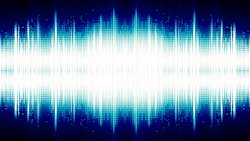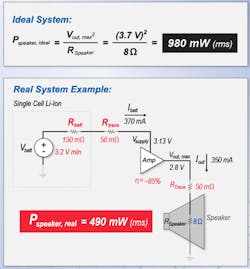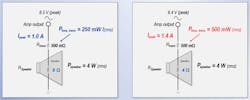Small Devices Deliver Big Audio with Boosted Amplifiers
Because we live in a world where music and entertainment surround us daily, it’s hard to believe that external speakers, which have brought great sound to the consumer audio experience, are now around 100 years old. From the earliest days of motion pictures to arena rock concerts and home theater systems, consumers have traditionally enjoyed audio in a very big way.
But for today’s mobile consumer, loud audio needs to come from small spaces. Really small spaces. Whether it’s listening to music with augmented-reality sunglasses, wearable neckbands, or a Bluetooth speaker so small it can fit in your pocket, to playing video games on virtual-reality headsets—they’ve all become common activities.
Devices that were previously “mute” or featured lackluster audio at best, are being re-imagined as they integrate into smart homes. Simple devices such as thermostats, home security cameras, and TV remotes now feature microphones and speakers in order to obey voice commands and respond to users. Even the smallest of connected devices, like smart watches, are providing differentiation by integrating speakers and microphones that enable users to make voice calls without a smartphone.
As devices get smaller, so do their power supplies. Lithium-ion batteries are very popular due to their long life and fast charging time. And 5-V power, such as from a USB connection, is a popular standard. But do these supplies have enough juice to deliver loud audio? In most cases, the answer is no.
For example, with a standard 3.7 V Li-ion as its power supply, a high-efficiency amplifier driving a typical 8-Ω speaker delivers less than 1 W of electrical power. When the battery is low on charge or as the battery gets older, the battery voltage will decrease while the battery impedance can get two to three times worse. This results in even less output power delivered to the speaker (Fig. 1).
So, why not just use lower-impedance speakers? This will increase output power, but also cause higher load current and larger power losses across traces or cables between the amp and speaker. (Fig. 2).
Boosted Audio Amplifiers on the Rise
Users want loud audio, but they still want long battery life and devices small enough to take anywhere. How can designers incorporate compelling audio into their systems without wasting power or space—all without breaking the bank? More and more frequently, one simple solution answers that question: boosted amplifiers. These tiny devices integrate a dc-dc boost regulator and a highly efficient Class D audio amplifier all in one small package, with four key advantages:
- Louder audio: The boosted voltage rail enables the amp to drive higher electrical power than a non-boosted system.
- Efficiency: By tightly coupling the boost and output stage in one integrated control loop, boosted amps have a higher efficiency (η = ηboost*ηamplifier) than a two-chip solution with independent dc-dc boost and amplifier.
- Size and cost: The solution size can be smaller than a two-chip system with independent amp and boost converter, often at a lower price. A typical smartwatch PCB size may be on the order of 3 in.2, with most of that taken by essential components such as the processor and wireless communication modules. In applications like this, maximizing loudness can’t come at the expense of size, requiring a highly integrated solution.
- Simplicity: Integrating the two functional blocks simplifies system integration, including reduced pin count, fewer PCB traces, and fewer components.
Not all boosted amps are alike. Architectures have evolved to increase voltage, output power, and power efficiency. Class G configurations provide two or three different boost output-voltage levels. The boost converter automatically selects the minimum output-voltage level needed based on audio content to minimize switching losses. Class H designs feature a boost where the output voltage follows the audio envelope for maximum efficiency (Fig. 3 compares Class G and Class H boosted amps). Even within the Class H category, not all boosts are created equal.
It’s important to consider how fast and how closely the boost voltage tracks the audio envelope. For example, the CS35L41 audio amplifier from Cirrus Logic features a fast-tracking 11-V Class H boost converter. It’s also one of the first boosted amplifiers using 55-nm processing, according to the company. This enables most of the processing to be packed into a small area compared to larger analog amplifier processes like 130 or 180 nm, leading to a tighter and faster boost-converter control loop.
In summary, a boosted amplifier can give audio a much-needed loudness “boost” in devices with low-voltage supplies, with longer battery life, smaller size, and lower cost compared to a two-chip solution. Thanks to today’s boosted amplifiers, manufacturers can give consumers great sounding audio from a small space, while maximizing battery life.
Kurt Efaw is a Product Marketing Engineer at Cirrus Logic.



